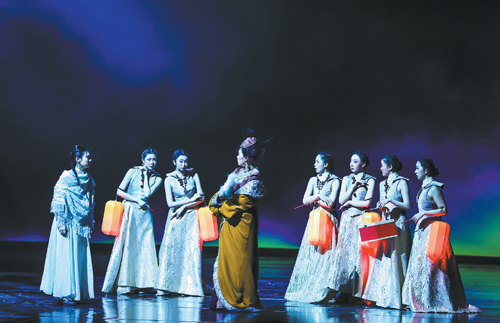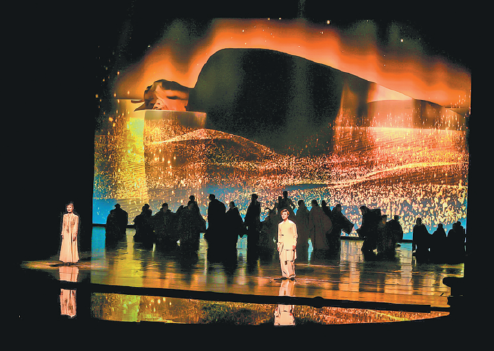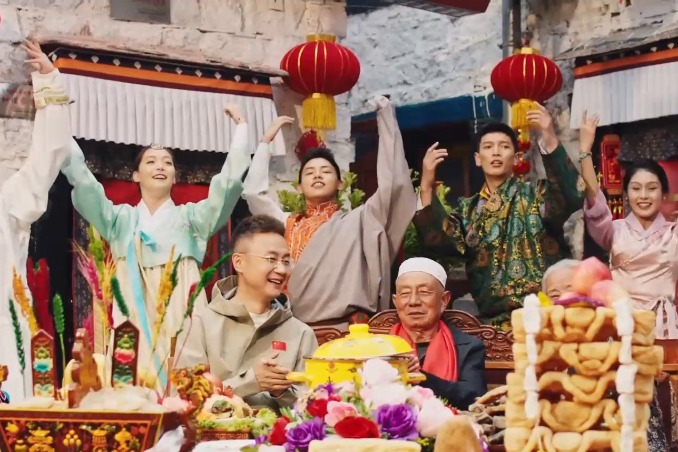From caves to the stage
A new musical takes the Mogao Grottoes as its setting and subject, innovatively blending genres, cultures and eras, as well as myth with reality, Cheng Yuezhu reports.

Several years ago, stage musical producer Li Dun spent seven days visiting the Mogao Grottoes in Dunhuang, Northwest China's Gansu province, admiring the murals and learning about the Buddhist stories depicted.
One of the Jataka tales in Buddhist legends — that of Prince Sattva sacrificing himself to feed hungry tigers — moved him to tears. After a long time of gazing at the mural in an almost trance-like state, Li thought of producing a musical centered on the heritage site and those who devote their lives to its preservation.
"The tale of Prince Sattva embodies sacrifice and the great love of humanity. Following this thought, the idea for the theme song to be titled Sacrifice emerged," Li says.
"Sacrifice holds great significance for human societies. If we could all show a bit of humility and make some sacrifices, the world would be more peaceful and society would be infused with a touch of warmth."
Li contacted composer San Bao and playwright Guan Shan, with whom he had collaborated in 2007 on the acclaimed musical Butterflies. They had promised to work together again.
The show's development also involved such veteran theater practitioners as director Chen Shizheng, dance director Jiang Yang and lighting designer Ren Dongsheng, as well as performers from theater troupes as the China Oriental Performing Arts Group. The production crew made field trips to Dunhuang 10 times since the project's conception in 2016.
"All three of us take it extremely seriously. San Bao jokingly said that the first script that Guan Shan wrote would take more than three months to perform. I suggested that we need only to capture the essence and cut down on the script," Li says.
Titled Flying Apsaras, the musical hosted concerts in 2023, presenting 14 original songs. And from April 25 to 27, the production premiered at Beijing's Poly Theatre in its full splendor.
Beginning from May 1 to 12, it was staged at the Dunhuang Grand Theater and then at the Lanzhou Concert Hall from May 15 to Sunday in Gansu's capital. It is also scheduled to run at the upcoming 18th Daegu International Musical Festival in South Korea and tour 13 Chinese cities with 50 performances starting from August.
The story is set in the 1930s and centers on two main characters — the guardian, who safeguards the murals from both natural disasters and human threats, and the traveler, who chances across a catalog of Dunhuang murals and decides to devote himself to the site's preservation.
These characters are based on and pay tribute to the generations of experts who've dedicated their lives to the protection of Dunhuang culture, epitomized by the founding director of the Dunhuang Academy, Chang Shuhong (1904-94).
The academy dedicated to the preservation and research of Dunhuang's ancient grottoes is celebrating its 80th anniversary this year.
Back in 1935, Chang was studying oil painting in Paris, where he stumbled upon a photo collection of Dunhuang murals and statues. He was awed by their artistry and concerned about their protection, so he went to Dunhuang where he spent four decades working to preserve its heritage.
According to the musical's director, Chen Shizheng, the show's core lies in exploring the brilliance of human nature and magnitude of human emotions.
"The guardian remains at the caves out of her love for Dunhuang and the traveler rushes from Paris to pursue Dunhuang's art. Both are chasing their dreams, which is an intangible concept," Chen says.
The production extensively employs digital art and projection technology to convey this. Some scenes feature projections from three angles to generate a sense of perspective and depict the murals before, during and after restoration.
"For example, the guardian lives in one of the caves. Through the use of projection, the audience can see the cave, the mural, the scaffolding set up to restore it, and the oil lamp and makeshift bed where she sleeps," Chen says.
"This contrasts the toil of the preservers with the sublimity of the murals, allowing the audience to understand the relationship between art and humanity."
Including the Prince Sattva story, the musical incorporates four representative Jataka tales that intertwine with the main storyline that demonstrate Dunhuang culture and promote the virtue of benevolence.
"Guan Shan ingeniously integrates four Jataka tales by having the male and female protagonists play the roles within these tales, so that the destinies of the traveler and the guardian are closely connected with the characters on Dunhuang murals. It's a contemporary way of presenting ancient myths," Chen says.
The choreography merges dance styles from various regions and eras, as Dunhuang was a pivotal interchange on the ancient Silk Road, serving as a hub for commerce and cultural exchanges between the East and the West.
"Because this musical is about the authenticity, goodness and beauty found in our profound Chinese traditional culture, I drew inspiration from tradition and incorporated the expressive movements of traditional dance styles, such as the gestures of the flying apsaras. But I innovated upon them by also integrating contemporary genres, including ballet and tap," dance director Jiang Yang says.
"Every member of our production crew hopes that this musical is something different — something brand new — that can serve as a valuable addition to China's original musicals and that audiences from all over the world can feel the depth and scope of traditional Chinese culture from it."



Today's Top News
- Israel's Gaza takeover plan widely condemned
- S. Korea visa waiver spurs surge in travel interest
- Top cities signal easing to support property market
- Ties bolster heritage protection
- Gaza 'takeover' will ignite another horrific chapter for the Middle East: China Daily editorial
- STAR shines for innovative companies































